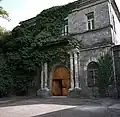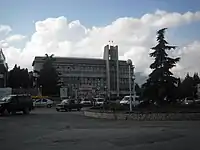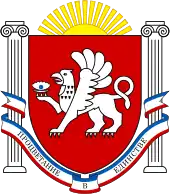Alushta
Alushta (Ukrainian: Алушта; Crimean Tatar: Aluşta; Greek: Ἄλουστον) is a city of regional significance on the southern coast of the Crimean peninsula which is within the Republic of Crimea, an internationally recognized de jure part of Ukraine, but since 2014 a de facto federal subject of the Russian Federation. It is located along the Black Sea coast on the road from Gurzuf to Sudak, as well as on the Crimean Trolleybus line. Population: 29,078 (2014 Census).[2]
Alushta
| |
|---|---|
 | |
 Flag  Coat of arms | |
.jpg.webp) Alushta Location of Alushta within Crimea  Alushta Alushta (Ukraine) | |
| Coordinates: 44°40′2″N 34°23′52″E | |
| Country | Territory of Ukraine, occupied by Russia[1] |
| Republic | |
| Municipality | Alushta Municipality |
| Area | |
| • Total | 6.983 km2 (2.696 sq mi) |
| Elevation | 50 m (160 ft) |
| Population (2014) | |
| • Total | 29,078 |
| • Density | 4,200/km2 (11,000/sq mi) |
| Time zone | UTC+2 (MSK) |
| Postal code | 298500 — 298519 (Russia) |
| Area code | +7-36560 |
| Former name | Aluston ('till the 15th century) |
| Climate | Cfa |
| Website | alushta.rk.gov.ru |
The area is notable for its arid, rocky terrain due to its proximity to the Crimean mountains. During Byzantine times, the town was called Alouston (Ἄλουστον) meaning "Unwashed".[3] Vestiges survive of a Byzantine defensive tower from a fortress from which the town's name was derived, as well as a 15th-century Genoese fortress. During Genoese rule, the name was modified to Lusta. Adam Mickiewicz dedicated two of his Crimean Sonnets to Alushta.
It is also the home of Seyit the Wolf in the Turkish drama, Kurt Seyit ve Sura.
In 1910, 544 Jews lived in Alushta, comprising 13% of the town's population. By 1939, they made up only 2.3% of the town's overall population, numbering 251 individuals. On 4 November 1941, the Germans occupied the town. On 24 November 1941, a unit of Sonderkommando 10b murdered 30 Jews by shooting along with captured communists and partisans. In early December 1941, about 250 Jews from Alushta were shot to death by Sonderkommando 11b in the park of Trade Union Sanatorium No. 7, which is today part of the local center for children and creativity.[4]
Geography
Climate
Alushta has a humid subtropical climate (Köppen climate classification: Cfa) that closely borders on a hot-summer Mediterranean climate (Köppen climate classification: Csa).
| Climate data for Alushta (1981–2010) | |||||||||||||
|---|---|---|---|---|---|---|---|---|---|---|---|---|---|
| Month | Jan | Feb | Mar | Apr | May | Jun | Jul | Aug | Sep | Oct | Nov | Dec | Year |
| Average high °C (°F) | 6.8 (44.2) |
6.7 (44.1) |
9.2 (48.6) |
13.9 (57.0) |
19.6 (67.3) |
24.6 (76.3) |
28.0 (82.4) |
27.9 (82.2) |
23.3 (73.9) |
17.7 (63.9) |
12.2 (54.0) |
8.4 (47.1) |
16.5 (61.7) |
| Daily mean °C (°F) | 3.6 (38.5) |
3.1 (37.6) |
5.4 (41.7) |
10.1 (50.2) |
15.3 (59.5) |
20.2 (68.4) |
23.4 (74.1) |
23.4 (74.1) |
18.5 (65.3) |
13.2 (55.8) |
8.2 (46.8) |
5.0 (41.0) |
12.5 (54.5) |
| Average low °C (°F) | 0.8 (33.4) |
0.1 (32.2) |
2.2 (36.0) |
6.7 (44.1) |
11.3 (52.3) |
15.9 (60.6) |
19.0 (66.2) |
18.5 (65.3) |
14.0 (57.2) |
9.3 (48.7) |
4.8 (40.6) |
2.1 (35.8) |
8.7 (47.7) |
| Average precipitation mm (inches) | 46.9 (1.85) |
42.5 (1.67) |
37.9 (1.49) |
29.5 (1.16) |
24.3 (0.96) |
39.4 (1.55) |
32.4 (1.28) |
41.4 (1.63) |
34.2 (1.35) |
38.0 (1.50) |
44.4 (1.75) |
52.6 (2.07) |
463.5 (18.25) |
| Average precipitation days (≥ 1.0 mm) | 8.0 | 7.1 | 6.8 | 5.6 | 5.7 | 5.7 | 4.1 | 4.3 | 4.2 | 4.9 | 7.0 | 8.2 | 71.6 |
| Average relative humidity (%) | 78.7 | 77.5 | 77.1 | 77.1 | 74.7 | 71.3 | 65.5 | 64.7 | 70.0 | 75.6 | 78.9 | 78.5 | 74.1 |
| Source: World Meteorological Organization[5] | |||||||||||||
Gallery
 15th century Genoese tower in Alushta
15th century Genoese tower in Alushta Villa "Otrada" (Stakheev's dacha)
Villa "Otrada" (Stakheev's dacha) Downtown Alushta
Downtown Alushta Park Alushti
Park Alushti Park Alushti
Park Alushti Alushta Beach
Alushta Beach In Alushta. Season-2014
In Alushta. Season-2014 Alushta winery
Alushta winery St. Theodore Church
St. Theodore Church Main square
Main square Panorama of Alushta in the 1850s, by Carlo Bossoli
Panorama of Alushta in the 1850s, by Carlo Bossoli Rotunda, a tourist attraction
Rotunda, a tourist attraction.JPG.webp) Quay
Quay Remains of Aluston fortress
Remains of Aluston fortress Alushta Beach. July 2014
Alushta Beach. July 2014 Quay. 2014
Quay. 2014 On the way. 2015
On the way. 2015 Cinema "Storm"
Cinema "Storm" Memorial sign in honor of the Crimean partisans in Alushta
Memorial sign in honor of the Crimean partisans in Alushta Alushta City Council building
Alushta City Council building one of the symbols of Alushta
one of the symbols of Alushta._%D0%90%D0%BB%D1%83%D1%88%D1%82%D0%B0._%D0%9A%D1%80%D1%8B%D0%BC._%D0%98%D1%8E%D0%BD%D1%8C_2009_-_panoramio.jpg.webp) Aluston fortress (IV-VI centuries). In exchange. Crimea. June
Aluston fortress (IV-VI centuries). In exchange. Crimea. June Monument to Liberators of Alushta
Monument to Liberators of Alushta Kenesa in Alushta
Kenesa in Alushta Kenesa in Alushta
Kenesa in Alushta

International relations
Twin towns — Sister cities
Alushta is twinned with:
References
- This place is located on the Crimean peninsula, which is internationally recognized as part of Ukraine, but since 2014 under Russian occupation. According to the administrative-territorial division of Ukraine, there are the Ukrainian divisions (the Autonomous Republic of Crimea and the city with special status of Sevastopol) located on the peninsula. Russia claims these as federal subjects of the Russian Federation (the Republic of Crimea and the federal city of Sevastopol).
- Russian Federal State Statistics Service (2014). "Таблица 1.3. Численность населения Крымского федерального округа, городских округов, муниципальных районов, городских и сельских поселений" [Table 1.3. Population of Crimean Federal District, Its Urban Okrugs, Municipal Districts, Urban and Rural Settlements]. Федеральное статистическое наблюдение «Перепись населения в Крымском федеральном округе». ("Population Census in Crimean Federal District" Federal Statistical Examination) (in Russian). Federal State Statistics Service. Retrieved January 4, 2016.
- Variants are Ἄλουστος (masc.), Ἀλοῦστον (neu.), Ἀλούστα (fem.) The feminine form, Alusta, is consistent with application to a city rather than a fortress. The anhydrous climate likely gave rise to a satirical, anthropomorphic appellation of “unwashed” to the place from resident(s). Χαραλαμπάκης, Παντελής. “Σκέψεισγια δυο Μεσαιωνικα Τοπωνυμια της Κριμαιαs, (Αλουστου, Παρθενιται)” [Reflections on two medieval names of Crimea (Aloustou, Parthenitai], Βυζαντινά Σύμμεικτα 23 (2013): 201–216; esp. 203, note 7.
- The murder of the Jews of Alushta during World War II, at Yad Vashem website
- "World Meteorological Organization Climate Normals for 1981–2010". World Meteorological Organization. Archived from the original on 17 July 2021. Retrieved 17 July 2021.
- "Sadraudzības pilsētas". jurmala.lv. Archived from the original on 4 March 2016. Retrieved 26 April 2014. (in Latvian and English)
